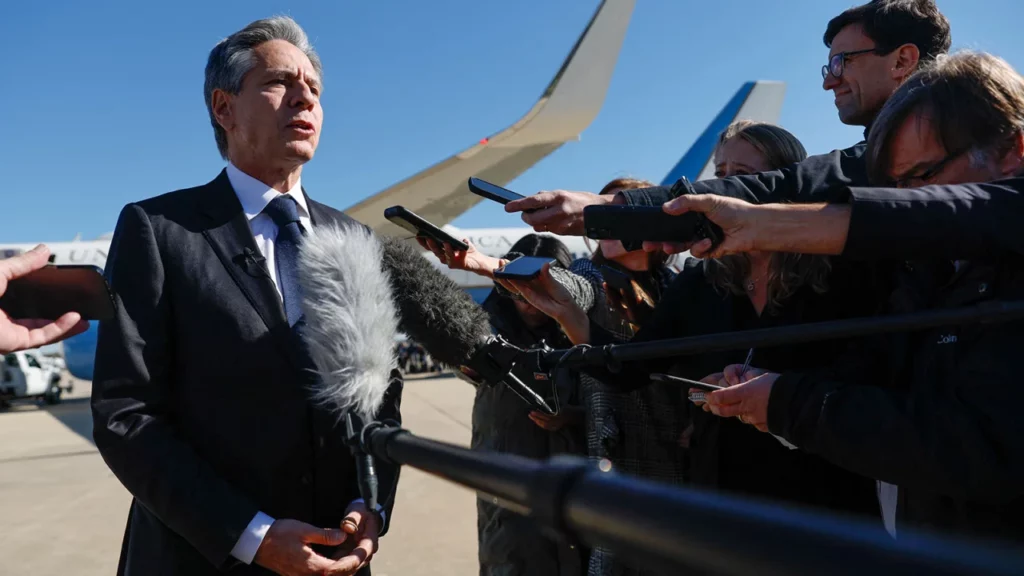In the face of growing international condemnation and an increasing number of civilian casualties, Secretary of State Antony Blinken visited Israel on Friday to put pressure on the Israeli government regarding its ongoing offensive in Gaza.
Following two trips to Israel last month in the wake of the deadly Hamas attack, the top US diplomat will meet with senior officials, including Prime Minister Benjamin Netanyahu, as the US government continues to try to strike a balance between supporting Israel’s defense and making a more visible case for them to protect civilians.
Before leaving Washington, DC, on Thursday, Blinken gave a press conference in which he stated his intention to speak with the Israeli government about “the ongoing campaign against the Hamas terrorist organization” and “steps that need to be taken to protect civilians.”
As with previous trips, he also plans to talk about preventing a wider regional conflict and the hostages held by Hamas.
Blinken would not directly respond when asked if Israel had so far shown restraint in its offensive, nor would he elaborate on the “concrete steps” being taken to better protect civilians. Rather, he claimed that this was “a crossfire of Hamas’ making,” denouncing the terrorist organization for embedding its fighters within civilian infrastructure and utilizing people as human shields in a “cynical and monstrous” manner.
“Seeing a boy or girl from Palestine pulled out of the wreckage of a fallen building gives me the same sense of urgency as seeing a child in Israel or anywhere else,” Blinken remarked. “We have a responsibility to address this, and we will.”
As international condemnation grows louder and wider, officials from across the US government have privately warned their Israeli counterparts about the impact of images like these and the importance of allowing humanitarian aid in.
Referring to the US experience with Mosul, Aleppo, and Fallujah, a source close to the situation said, “We are constantly saying you’re not going to have the time and the space to do what you want to do if these images just keep coming out day after day of the death and destruction that’s happening inside of Gaza.” “It’s a message that gets repeated all day, every day, at all levels.”
Israel’s Gaza campaign has drawn harsh criticism from its Arab allies, with Jordan and Bahrain recalling their ambassadors.
Blinken stated on Thursday that another major topic of his talks in Israel will be the ongoing evacuation of civilians and the supply of humanitarian aid.
Beginning on Wednesday, civilians—including citizens of the United States—were permitted to exit Gaza through Egypt’s Rafah Gate, and authorities predicted that these departures would persist in the upcoming days.
Even still, getting there took weeks of laborious work and considerable high-level US pressure on the concerned parties.
Over the past week, a constant flow of trucks bearing aid have been allowed entry, but Blinken and other US officials have emphasized that this is far from sufficient. Additionally, Israeli authorities have restricted the amount of fuel that can enter Gaza, claiming that Hamas has embezzled vast amounts and kept it from civilians.
The urgent need for fuel to keep hospitals operating has been emphasized by aid and medical personnel, and Blinken is expected to bring up the issue in his meetings on Friday. Senior officials have brought up the matter, a familiar source told .
Talking about “the day after” and “how we can set the conditions for a durable, sustainable peace; durable, sustainable security for Israelis and Palestinians alike” is Blinken’s third top priority during his visit to Israel, he stated on Thursday.
The top US diplomat has stated time and time again that the “status quo” with Hamas cannot be restored, and Israeli officials have declared their intention to drive the organization out of Gaza.
Blinken stated that Israel cannot rule or control Gaza in congressional testimony on Monday, saying, “That’s not their intent, that’s not what they want to do, and it’s not something that would be supported.”
“Eventually, it would be most sensible for Gaza’s governance and security to be under the control of an efficient and resurgent Palestinian Authority,” the speaker stated.
We need to examine the important question of whether you can arrive there in a single step. If you are unable to, there are alternative short-term agreements available that might involve several other nations in the area. International organizations that support governance and security may be involved.
Blinken stated he anticipated a special emphasis on “how we can get over time to two states for two peoples” in his talks in Israel. Nonetheless, considering the current offensive in Gaza and the increasing violence perpetrated by Israeli settlers in the West Bank, the prospect of a two-state solution appeared especially improbable.
The US has “made quite clear to the government of Israel that we are very concerned about settler violence in the West Bank,” according to State Department spokesman Matt Miller on Wednesday.
It is extremely unsettling to us. At a department briefing, he stated, “We find it extremely harmful to Palestinians living in the West Bank and counterproductive to Israel’s long-term security.”
Miller stated, “We have made it very evident to them that this behavior is unacceptable, that it must end, and that those who are accountable for it must bear consequences.”





